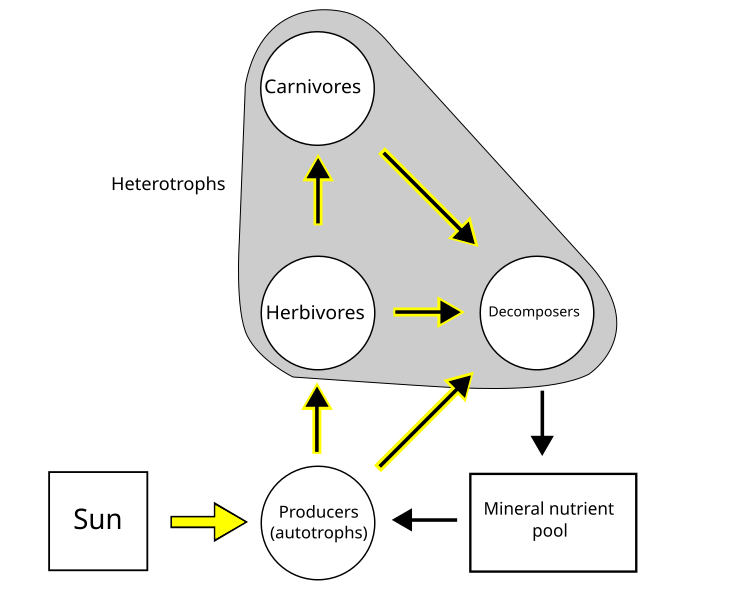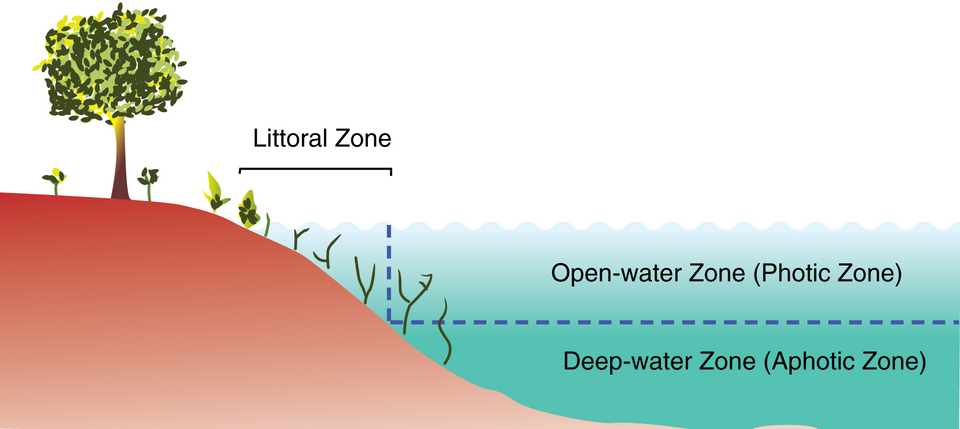OCR Specification focus:
‘Define ecosystems of different sizes and explain how biotic and abiotic factors interact to influence their dynamics, with named examples.’
Ecosystems are dynamic systems where living organisms interact with each other and their physical environment, creating interdependent relationships shaped by biotic and abiotic factors.
Ecosystems and Their Structure
An ecosystem is a biological community of interacting organisms and their physical environment. It includes both living (biotic) and non-living (abiotic) components that exchange energy and matter.
Ecosystem: A community of organisms and their physical environment interacting as a system through energy flow and nutrient cycling.
Ecosystems exist on many scales:
Micro-ecosystems such as a decaying log or a pond.
Meso-ecosystems like a forest, coral reef, or grassland.
Macro-ecosystems (biomes) such as tropical rainforests, deserts, or tundra regions.
Each scale demonstrates similar principles of energy flow, nutrient cycling, and organism interactions, although complexity and diversity differ.
Biotic Factors and Their Roles
Biotic factors are the living components that shape the ecosystem’s structure and functioning. They include producers, consumers, and decomposers.
Producers
Producers (autotrophs) convert sunlight energy into chemical energy through photosynthesis. They form the base of all food chains and determine the amount of energy available to higher trophic levels.
Consumers
Consumers (heterotrophs) depend on other organisms for energy:
Primary consumers (herbivores) feed directly on producers.
Secondary and tertiary consumers (carnivores and omnivores) feed on other consumers.
Decomposers and Detritivores
Decomposers, such as bacteria and fungi, break down dead organic matter into simpler compounds, recycling nutrients back into the soil.
Detritivores, like earthworms and woodlice, physically fragment dead material, aiding decomposition.
These organisms maintain nutrient cycling, ensuring continuous productivity and stability within ecosystems.
Abiotic Factors and Environmental Influence
Abiotic factors are non-living components that affect organism survival, distribution, and population dynamics. They include:
Temperature – influences enzyme activity and metabolic rates.
Light intensity – affects photosynthesis and plant distribution.
Water availability – controls transpiration rates and habitat suitability.
Soil type and pH – determine nutrient availability and plant root growth.
Oxygen and carbon dioxide levels – affect respiration and photosynthesis.
Topography – influences drainage, exposure, and microclimates.
Each factor interacts with others to form specific environmental niches that support diverse life forms.
Interactions Between Biotic and Abiotic Factors
Ecosystem dynamics rely on continuous interactions between biotic and abiotic components. These interactions regulate energy transfer, population balance, and successional change.
For example:
Plants depend on light, water, and minerals to photosynthesise; their growth influences herbivore populations.
Soil microorganisms regulate nutrient recycling, affecting plant productivity.
Climate conditions control species distributions by setting physiological limits.
Changes in abiotic conditions often drive adaptation and competition, altering community composition over time.
Energy Flow and Ecosystem Dynamics
Energy flows through an ecosystem in one direction, from the sun to producers, then through various consumer levels before being lost as heat.

Simplified food web showing energy transfer from the sun through producers to successive consumers, with heat loss at each step. Decomposers return nutrients to the abiotic environment, completing nutrient cycling. This diagram includes only core pathways to keep the interactions clear. Source.
Trophic level: A position in a food chain representing a step in energy transfer.
Energy is passed along food chains but diminishes at each level due to respiratory losses and inefficient energy conversion, influencing population size and biomass structure.
Key concepts:
Gross primary productivity (GPP): total energy captured by photosynthesis.
Net primary productivity (NPP): energy remaining after plant respiration, available to consumers.
Abiotic conditions such as light intensity, temperature, and nutrient availability strongly influence these productivity measures, shaping overall ecosystem output.
Factors Influencing Ecosystem Dynamics
Ecosystem dynamics describe the changes and interactions that maintain equilibrium. These include natural variations and external disturbances.
Density-Dependent Factors
These depend on population size and include:
Competition for resources such as food, space, and light.
Predation, which regulates prey numbers.
Disease, spreading faster in denser populations.
Density-Independent Factors
These operate regardless of population size and include:
Extreme weather events, such as droughts or floods.
Pollution and habitat destruction.
Seasonal temperature variation, affecting reproduction and migration.
Both factor types influence carrying capacity, the maximum population an environment can sustain.
Dynamic Equilibrium and Feedback
Ecosystems exhibit dynamic equilibrium, meaning populations fluctuate around stable means due to feedback mechanisms.
Negative feedback maintains stability by counteracting changes (e.g., population control through limited resources).
Positive feedback can amplify changes, potentially leading to ecosystem shifts (e.g., desertification following vegetation loss).
These mechanisms ensure resilience — the ability of an ecosystem to recover from disturbance while maintaining its essential functions.
Case Studies of Ecosystem Interactions
Example 1: The Freshwater Pond
A pond ecosystem illustrates how light availability, temperature, and nutrient levels affect aquatic plants and phytoplankton growth.

Diagram of lake zones showing the shallow littoral, sunlit open-water/limnetic (photic), and dark deep-water/profundal (aphotic) regions. These abiotic gradients control photosynthesis, oxygen distribution and community composition. Terminology matches standard limnology and may include synonyms noted in the labels. Source.
Increased light promotes photosynthesis, increasing oxygen levels that support fish and invertebrates. Seasonal temperature changes cause stratification, altering oxygen distribution and influencing species survival.
Example 2: The Tropical Rainforest
In rainforest ecosystems, high rainfall and temperature support rapid plant growth and biodiversity. Decomposers recycle nutrients quickly, yet poor soil quality limits nutrient retention. When deforestation occurs, abiotic conditions change — reduced canopy cover increases light and temperature variability, altering community structure.
Example 3: The Arctic Tundra
Here, extreme cold, low precipitation, and permafrost restrict biodiversity. Plant life is limited to mosses and lichens adapted to short growing seasons. These abiotic factors define food web simplicity and limit productivity.
Human Influences on Ecosystem Dynamics
Human activity often modifies abiotic and biotic relationships.
Key influences include:
Pollution altering water and soil chemistry.
Deforestation reducing biodiversity and carbon storage.
Climate change shifting temperature and precipitation patterns, impacting species distributions.
Urbanisation and agriculture changing nutrient flow and energy transfer through ecosystems.
These pressures disrupt natural feedback systems, often leading to reduced ecosystem resilience and loss of ecological balance.
Maintaining Ecosystem Function
Sustainable management requires understanding the interplay between biotic and abiotic factors. Monitoring these helps predict ecological responses to disturbance and supports conservation strategies that preserve biodiversity and ecosystem services such as pollination, nutrient cycling, and climate regulation.
By recognising that ecosystems operate through complex interactions rather than isolated processes, biologists can better explain and manage the dynamic nature of the natural world.
FAQ
A habitat is the specific physical environment where a species or community lives — for example, a rock pool or oak tree canopy. It focuses on the place.
An ecosystem, however, includes not only the habitat but also the interactions between living (biotic) and non-living (abiotic) components, such as nutrient cycles and energy transfer.
In short: a habitat is part of an ecosystem, but an ecosystem covers the full web of interactions and processes within that environment.
A microclimate is a small-scale variation in climate conditions within a larger ecosystem, caused by features such as shade, shelter, or water proximity.
These microclimates influence:
Species distribution (e.g. mosses growing on damp north-facing walls).
Behavioural patterns (e.g. animals using shaded areas to avoid overheating).
Local biodiversity by creating niches for specialised organisms.
Microclimates add complexity to ecosystems, supporting a variety of species within a relatively small area.
Decomposers, including bacteria and fungi, break down dead organic matter into inorganic nutrients like nitrates and phosphates.
This process:
Recycles essential nutrients into the soil for uptake by producers.
Prevents accumulation of waste and dead material.
Maintains a balanced carbon and nitrogen cycle.
Without decomposers, nutrient cycling would stop, leading to reduced plant growth and eventual collapse of food webs.
Seasonal changes modify temperature, light intensity, and rainfall, all of which alter biological activity.
Winter: Lower temperatures slow enzyme activity, reducing photosynthesis and growth rates.
Spring/Summer: Increased light and warmth accelerate reproduction and biomass production.
Autumn: Leaf fall contributes to detritus, fuelling decomposer activity.
These cycles create predictable fluctuations in population size, productivity, and energy flow, forming part of the ecosystem’s natural rhythm.
Ecosystem resilience is its ability to recover after disruption while maintaining essential functions.
Factors increasing resilience include:
High biodiversity, offering alternative species to fill ecological roles.
Complex food webs, distributing energy flow through multiple pathways.
Healthy abiotic conditions, such as fertile soil and stable climate.
For instance, a diverse grassland may recover from fire faster than a monoculture field, as more species can re-establish ecological balance.
Practice Questions
Question 1 (2 marks)
Define the term ecosystem and explain what is meant by a biotic factor within an ecosystem.
Mark scheme:
1 mark: Correct definition of ecosystem — a community of organisms and their physical environment interacting as a system through energy flow and nutrient cycling.
1 mark: Correct explanation of biotic factor — any living component of the environment that affects other organisms (e.g. competition, predation, or disease).
Question 2 (5 marks)
Describe and explain how abiotic factors can influence the distribution and abundance of organisms in an ecosystem. Use examples in your answer.
Mark scheme:
1 mark: States that abiotic factors are non-living physical and chemical components of an environment.
1 mark: Mentions that abiotic factors determine where species can survive and reproduce.
1 mark: Explains at least one specific abiotic factor (e.g. light intensity, temperature, water availability, pH, or soil type) and its effect on organisms.
1 mark: Provides an example, such as plant growth being greater in areas with high light availability or temperature affecting enzyme activity and metabolic rate.
1 mark: Links abiotic variation to differences in abundance or distribution across habitats (e.g. certain fish species only present in oxygen-rich waters).

